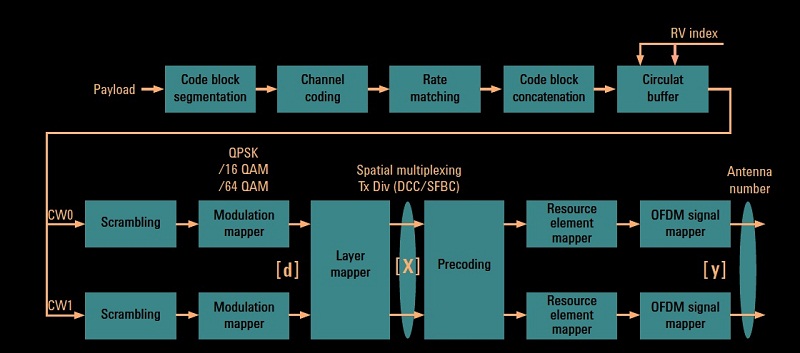Codeword, layer, and precoding in LTE
Terms codeword, layer, and precoding have been taken to refer specifically to LTE signals and processing. The figure shows the processing steps to which they relate. The terms used in the following ways:
Codeword: codeword represents the user data before it is formatted for transmission. One or two code words, CW0 and CW1, may be used depending on the conditions of the channel and the use case. In the most common case of a single user MIMO (SU-MIMO), two codewords are sent to a single handset UE, but less common for downlink multi-user MIMO (MU-MIMO), each codeword is sent only one UE.
Layer: The term is synonymous with the current. For MIMO, the use of at least two layers. Up to four layers are allowed .The Number is always less than or equal to the number of antennas.
Precoding: Precoding layer modifies signals before transmission. This can be done diversity, spatial multiplexing, or beam direction. MIMO channel conditions may favor one layer (data stream) to another. If the base station (eNB) is given channel (e.g., the information sent back from the UE), the complex may be added to counter the imbalance cross-coupling in the channel. In arrangement 2 * 2, LTE uses a single stop 1 to 3 Precoding, which improves the performance if the channel has not changed too rapidly.
Eigen beamforming: (sometimes known simply as “beamforming”) amends the transmission signals to provide the best transportation to interference and noise ratio (CINR) out of the channel.
2 x 1 Tx diversity, 2 layers, 1 code word (2) Level Assignment: This is the process of assigning each codeword to one or more levels. See page Layer Mapping. (3) Pre-coding: This is a process in which the layer data is assigned to several antenna ports (logical antenna ports in this phase).
Codeword, Layer, and Precoding in LTE
In LTE, the transmission of data is done through multiple antennas using advanced techniques like MIMO (Multiple Input Multiple Output). Key concepts in this process include codewords, layers, and precoding. These elements work together to improve the data throughput, reliability, and efficiency of the LTE network.
Codeword: A codeword refers to a unit of data that is transmitted across the network. In LTE, the data to be transmitted is split into one or more codewords. A codeword is a stream of bits or symbols that is encoded and transmitted by the eNodeB (evolved Node B) to the UE (User Equipment). The number of codewords transmitted depends on the modulation scheme and the number of spatial layers being used. Typically, LTE supports one or two codewords in the downlink.
Layer: A layer in LTE refers to a spatial stream that carries a part of the transmitted data. Layers are associated with MIMO technology, where multiple spatial streams (layers) are transmitted simultaneously, each on a separate antenna at the transmitter. The number of layers corresponds to the number of spatial streams that can be used in the transmission. For example, in a 4×4 MIMO system, four spatial layers can be transmitted simultaneously. The number of layers typically depends on the channel conditions and the number of antennas available at both the eNodeB and UE.
Precoding: Precoding is the process of modifying the transmitted signal based on channel conditions to optimize performance, improve signal strength, and reduce interference. It is used in MIMO systems to pre-process the transmitted data before it is sent over the air. In LTE, precoding adjusts the signal by applying specific weights to the different antennas to improve signal quality and maximize throughput. Precoding can be done in different forms, such as:
- Linear Precoding: A technique where each antenna’s signal is scaled according to the channel state information (CSI) from the receiver. This reduces interference between layers and helps in improving the signal quality for the receiver.
- Closed-Loop Precoding: This involves feedback from the receiver (UE) to the transmitter (eNodeB) about the channel conditions, allowing the eNodeB to adjust the precoding matrix dynamically. This feedback enables more efficient transmission and better use of the available spatial resources.
- Open-Loop Precoding: In this case, there is no feedback from the receiver. The eNodeB uses predefined algorithms and information about the channel to perform the precoding without real-time adjustments from the UE. It is typically used in simpler MIMO configurations.
How These Concepts Work Together:
- In LTE, the data is divided into codewords, which are then mapped to spatial layers based on the number of available antennas at the transmitter and receiver. Each spatial layer is independently transmitted, increasing the overall throughput.
- Precoding is applied to these layers before transmission to ensure that the signals from the different antennas combine in a way that maximizes the signal quality and minimizes interference.
In summary, codewords, layers, and precoding are crucial components in LTE for efficient data transmission. Codewords carry the data, layers allow the simultaneous transmission of multiple data streams, and precoding ensures that these streams are transmitted in the most optimal way, improving overall system performance and user experience.
